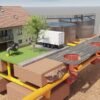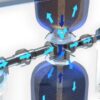
Have you ever found yourself pondering over the mysteries of a car crash or a workplace mishap, trying to piece together how it all unfolded? Welcome to the intriguing realm of accident reconstruction, a field that acts as a bridge between science and storytelling, unraveling the intricacies of accidents with precision and clarity. In this journey through accident reconstruction, we’ll delve into the question: “What Is Accident Reconstruction?” depths of this vital process, exploring how it works, why it matters, and why Austin Visuals emerges as the unrivaled choice for weaving together the threads of accident reconstruction animation.
Understanding Accident Reconstruction
Accident reconstruction is like being a detective, but instead of solving crimes, experts in this field investigate accidents. They use a combination of physics principles, engineering expertise, and cutting-edge technology to recreate the sequence of events leading up to an accident. This process involves analyzing evidence such as skid marks, vehicle damage, witness statements, and more to determine how and why the accident occurred.
The Role of Animation in Accident Reconstruction
Now, let’s zoom in on accident reconstruction animation. Imagine taking all the data and information gathered from an accident scene and bringing it to life in a virtual world. That’s exactly what animation does in accident reconstruction. It allows experts to create realistic simulations of the accident, showing how vehicles moved, where the impact occurred, and the forces involved.
But why is animation such a game-changer in accident reconstruction? Firstly, it provides a visual representation that is easy to understand for judges, juries, and other stakeholders involved in legal proceedings. Instead of relying solely on technical jargon and diagrams, animation simplifies complex concepts, making it easier for everyone to grasp the key points. Check out “The Transformative Power of Court Animation in Legal Proceedings” to enhance case presentations and improve jury comprehension.
Secondly, animation adds a layer of detail and accuracy that static images or diagrams can’t achieve. For example, it can show the speed and trajectory of vehicles, the timing of events, and even factors like weather conditions or road visibility. This level of detail is crucial in building a comprehensive narrative of what transpired during the accident.
Steps Involved in Accident Reconstruction
Accident reconstruction is a detailed process that involves several key steps to understand and recreate the events of an accident accurately. Here are the essential steps involved in accident reconstruction:
- Scene Examination: Accident reconstruction begins with a thorough examination of the accident scene. This includes documenting physical evidence such as skid marks, debris, vehicle positions, and any other relevant factors.
- Data Collection: Accident investigators gather data from various sources, including witness statements, police reports, surveillance footage, and vehicle data recorders (black boxes). This data provides crucial information about the circumstances leading up to the accident.
- Photographic Documentation: Photographs and videos are taken to document the scene, vehicle damage, road conditions, traffic signals, and any other pertinent details that can aid in the reconstruction process.
- Measurements and Diagrams: Accurate measurements of the accident scene are taken to create scaled diagrams. These diagrams depict the positions of vehicles, impact points, skid marks, and other relevant elements, helping investigators visualize the sequence of events.
- Vehicle Inspections: Vehicles involved in the accident are thoroughly inspected to assess damage, mechanical issues, and safety features. This information is crucial for understanding how the vehicles behaved during the collision.
- Analysis and Reconstruction: Using specialized software and mathematical models, accident reconstruction experts analyze the collected data to reconstruct the sequence of events. Factors such as vehicle speeds, trajectories, braking distances, and impact forces are calculated to create a comprehensive reconstruction.
- Simulation and Animation: Advanced computer simulations and animations are used to visualize the accident scenario. This includes recreating vehicle movements, collision dynamics, and the resulting damage, providing a clear depiction of what occurred during the accident.
- Expert Testimony: Accident reconstruction experts present their findings through expert testimony in legal proceedings. They explain the reconstruction process, analysis methods, and conclusions reached, helping judges, juries, and other stakeholders understand the complexities of the accident.
- Report Preparation: A detailed accident reconstruction report is prepared, documenting all findings, analysis results, simulations, diagrams, and expert opinions. This report serves as a crucial document for legal purposes, providing a comprehensive overview of the accident reconstruction process.
By following these steps meticulously, accident reconstruction experts can uncover vital information about how an accident occurred, contributing to the investigation, legal proceedings, and overall understanding of road safety and accident prevention.
Why Austin Visuals Stands Out
Now, let’s talk about why Austin Visuals is your go-to partner for accident reconstruction animation. Here are a few reasons that set them apart:
- Expertise: Austin Visuals boasts a team of experienced animators, engineers, and accident reconstruction specialists who understand the nuances of creating accurate and compelling animations.
- State-of-the-Art Technology: They leverage the latest software and tools in the industry to ensure that their animations are not just visually stunning but also scientifically sound.
- Customization: Every accident is unique, and Austin Visuals recognizes this. They tailor their animations to fit the specific details and requirements of each case, ensuring a personalized approach.
- Legal Credibility: Their animations are designed to meet the rigorous standards of legal proceedings, providing irrefutable evidence and bolstering your case.
- Collaborative Process: Austin Visuals involves clients throughout the animation process, from initial concept development to final delivery, ensuring that the end product meets expectations and serves its purpose effectively.
Conclusion
Accident reconstruction animation is a powerful tool that brings clarity and insight to complex accident scenarios. By partnering with a trusted provider like Austin Visuals, you gain access to expertise, technology, and a collaborative approach that can make a significant difference in your legal strategy. Whether it’s a car crash, workplace incident, or any other type of accident, having accurate and compelling animations can strengthen your case and lead to favorable outcomes.
Curious about the secrets hidden within accident scenes? Dive into the fascinating world of accident reconstruction with Austin Visuals. Let our expert team unravel the mysteries, provide clarity through advanced simulations, and support your legal strategies with compelling expert testimony. Experience the power of visualization with Austin Visuals today!
So, the next time you need top-notch accident reconstruction animation services, remember that Austin Visuals is the name you can rely on for excellence and reliability. Contact us today!
FAQs: What Is Accident Reconstruction
Why is accident reconstruction important?
Accident reconstruction is crucial for understanding liability, determining fault, and providing accurate information for legal proceedings, insurance claims, and safety improvements.
Who conducts accident reconstruction?
Accident reconstruction is typically performed by specialized professionals such as engineers, forensic experts, and accident reconstructionists who have expertise in analyzing accident data and creating simulations.
What types of accidents can be reconstructed?
Accident reconstruction can be applied to various types of accidents, including car crashes, industrial incidents, slip and fall accidents, and more, depending on the available evidence and the complexity of the case.
How long does accident reconstruction take?
The duration of accident reconstruction varies based on factors such as the complexity of the accident, the availability of data and evidence, and the extent of analysis required, but it typically involves several weeks to months for a thorough reconstruction process.




